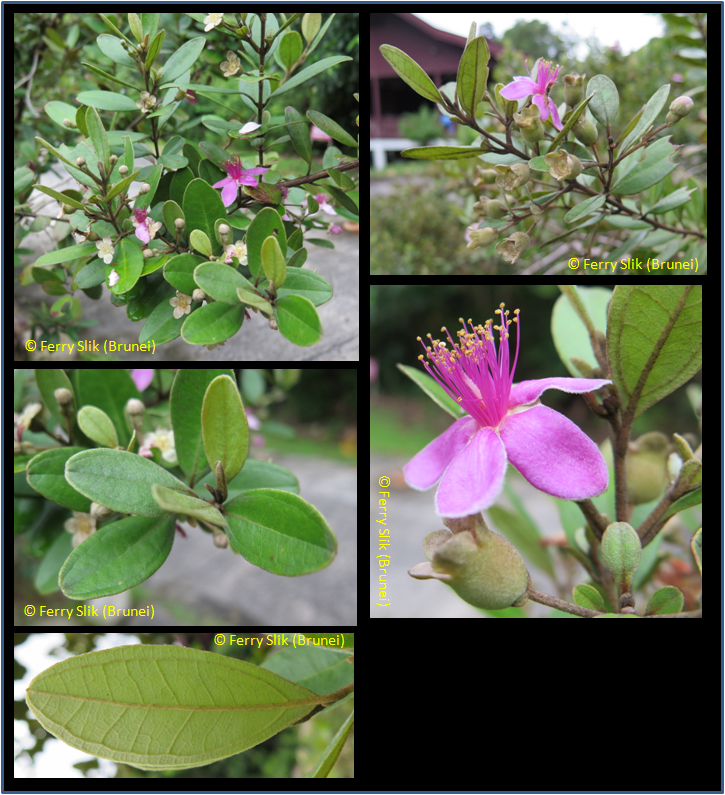Rhodomyrtus tomentosa (Solander ex Aiton) Hassk., Flora 25, 35 (1842)
Latin for 'shiny hairy'.Synonyms
Cynomyrtus tomentosa (Aiton) Scriv.
Myrtus canescens Lour.
Myrtus tomentosa Solander ex Aiton
Rhodomyrtus tomentosa var. tomentosa
Diagnostics
Shrub up to 5 m tall and 5 cm dbh. Stipules absent. Leaves opposite, simple,
penni-veined with conspicuous marginal vein (giving tripli-veined appearance),
hairy and whitish below. Flowers ca. 14 mm diameter, white-pink-purple, placed
in the leaf axills, with many protruding anthers. Fruits ca. 14 mm long,
green-reddish-black, berries.
Description
Evergreen shrub growing up to 4 m tall. The leaves are opposite, leathery, 5-7 cm long and 2-3.5 cm broad,
three-veined from the base, oval, obtuse to sharp pointed at the tip, glossy green above, densely grey or
rarely yellowish-hairy beneath, with a wide petiole and an entire margin. The flowers are solitary or in
clusters of two or three, 2.5-3 cm diameter, with five petals which are tinged white outside with purplish-pink
or all pink. The fruit is edible, 10-15 mm long, purple, round, three or four-celled, capped with persistent
calyx lobes, soft, with 40-45 seeds in a double row in each cell; seed dispersal is by frugivorous birds and
mammals. Seed production and germination rates are high.
Ecology
In open landscapes and shrubby kerangas, often near the coast, on poor sandy soils.
Thrives in open, often degraded sandy sites, along the shore and on river banks. Where it grows, other
plants seem not to be able to compete with it, hence almost pure stands exist. It tolerates full sun and
flooding. Up to elevations of up to 1300 m, but sometimes occurs in montane woodlands and grassland at altitudes
of 1800¡ª2700 m. Moist, somewhat acid soils are preferred; the plant is not well adapted to limestone soils.
It is able to invade a range of habitats, from pine flatwoods to mangrove marshes. It grows in a wide range
of soil types, including salty coastal soil, but is sensitive to heavy salt spray. It is fire-adapted, i.e.,
is able to resprout prolifically after fire. Has the potential to alter the natural fire regimes of invaded areas.
Uses
The wood is used to carve small objects. Children compete with birds for the sweet, edible fruit.
In some areas jam or jelly used to be made from
the fruit, but it is only incidentally available in quantity. Old sources in Malaysia mention the use of
the fruits as a cure for dysentery and diarrhoea. A decoction of the roots or leaves is drunk for diarrhoea
and stomachache, and as a protective medicine after birth. In Indonesia, the crushed leaves are used to
dress wounds. The wood-tar can serve as a black dye and has been used to blacken teeth and eyebrows. In
Java and in Florida, where the downy myrtle is cultivated in gardens, the ornamental value of the shrub and
its flowers is prized. It has shown promise as a fire retardant species for use in fire breaks in the Himalayas.
Distribution
Growing wild and cultivated throughout South-East Asia, India, Sri Lanka, and southern China.
Occasionally it is grown outside this area.
Local names
Borneo: Bekakangal, Kemuntian, Kemunting, Keramunsing, Keramunting.
English: Downy myrtle, rose myrtle.
Indonesia: kemunting (Malay), harendong sabrang (Sundanese).
Malaysia: kemunting (Peninsular Malaysia), karamunting (Sabah, Sarawak).
Cambodia: puech, sragan.
Thailand: thoh (Peninsular), phruat (Trat), phruat-kinluk (Prachin Buri).
Vietnam: sim.
